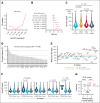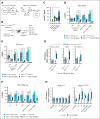Elevated B12 serum levels are associated with the presence of clonal hematopoiesis
- PMID: 40809192
- PMCID: PMC12346026
- DOI: 10.1016/j.bneo.2025.100136
Elevated B12 serum levels are associated with the presence of clonal hematopoiesis
Conflict of interest statement
Conflict-of-interest disclosure: The authors declare no competing financial interests.
Figures


Similar articles
-
Clonal hematopoiesis and inflammation in the vasculature: CHIVE, a prospective, longitudinal clonal hematopoiesis cohort and biorepository.Blood Adv. 2024 Jul 9;8(13):3453-3463. doi: 10.1182/bloodadvances.2023011510. Blood Adv. 2024. PMID: 38608257 Free PMC article.
-
Obesity-induced inflammation exacerbates clonal hematopoiesis.J Clin Invest. 2023 Jun 1;133(11):e163968. doi: 10.1172/JCI163968. J Clin Invest. 2023. PMID: 37071471 Free PMC article.
-
Human Immunodeficiency Virus and Clonal Hematopoiesis.Cells. 2023 Feb 22;12(5):686. doi: 10.3390/cells12050686. Cells. 2023. PMID: 36899822 Free PMC article. Review.
-
Association Between Rheumatoid Arthritis and Clonal Hematopoiesis: A Mendelian Randomization Study.Twin Res Hum Genet. 2024 Jun;27(3):169-173. doi: 10.1017/thg.2024.24. Epub 2024 Jun 3. Twin Res Hum Genet. 2024. PMID: 38828552
-
Diagnostic value of the mean corpuscular volume in the detection of vitamin B12 deficiency.Scand J Clin Lab Invest. 2000 Feb;60(1):9-18. doi: 10.1080/00365510050184994. Scand J Clin Lab Invest. 2000. PMID: 10757449
References
-
- Arendt JFH, Sørensen HT, Horsfall LJ, Petersen I. Elevated vitamin B12 levels and cancer risk in UK primary care: a THIN database cohort study. Cancer Epidemiol Biomarkers Prev. 2019;28(4):814–821. - PubMed
LinkOut - more resources
Full Text Sources

